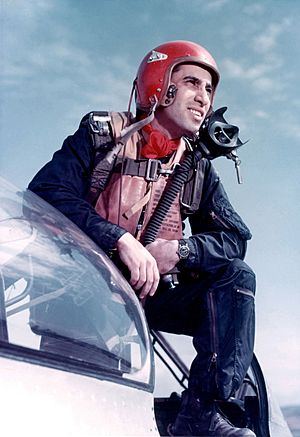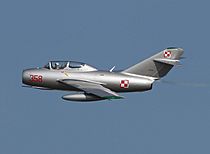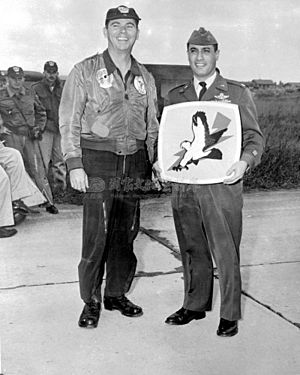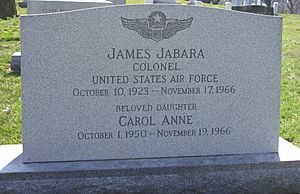James Jabara facts for kids
Quick facts for kids
James Jabara
|
|
|---|---|

(c.1950s)
|
|
| Nickname(s) | "Jabby", "The Ceegar Kid" |
| Born | 10 October 1923 Muskogee, Oklahoma, U.S. |
| Died | 17 November 1966 (aged 43) Delray Beach, Florida, U.S. |
| Buried | |
| Allegiance | United States of America |
| Service/ |
United States Army Air Forces United States Air Force |
| Years of service | 1943–1966 |
| Rank | Colonel |
| Commands held | 31st Tactical Fighter Wing 337th Fighter-Interceptor Squadron |
| Battles/wars | World War II Korean War Vietnam War |
| Awards | Distinguished Service Cross Silver Star (2) Distinguished Flying Cross (7) Air Medal (24) British Distinguished Flying Cross |
James "Jabby" Jabara (born October 10, 1923 – died November 17, 1966) was a brave American pilot. He made history as the first American and United States Air Force pilot to become a "jet ace." A flying ace is a pilot who has shot down five or more enemy aircraft in air combat.
Jabara grew up in Kansas and joined the military right after high school. He flew fighter planes in World War II and shot down 1.5 German aircraft. Later, he became famous during the Korean War. Flying a fast North American F-86 Sabre jet, he shot down 15 enemy MiG-15 jets. This made him the first American jet ace and later a "triple ace" (meaning he had 15 victories). He was the second-highest-scoring U.S. ace in the Korean War.
For his amazing skills and bravery, Jabara received many important awards. These included the Distinguished Service Cross and the Silver Star. After his combat tours, he continued to serve in the Air Force. Sadly, he died in a car accident in 1966. Today, an airport in Kansas and a special award at the United States Air Force Academy are named in his honor.
Contents
Early Life and Becoming a Pilot
James Jabara was born in Muskogee, Oklahoma. His parents came from a town called Marjayoun in Lebanon. From a young age, James dreamed of flying. He was a Boy Scout and even became an Eagle Scout. He loved reading stories about famous pilots like Eddie Rickenbacker.
After finishing high school in Wichita, Kansas, in 1942, James joined the United States Army Air Corps. He was a bit short for a fighter pilot, standing five feet, five inches tall. He even tried eating 20 carrots a day, thinking it would improve his eyesight for flying! After training at four different flying schools in Texas, he earned his pilot's wings in October 1943. He also became a second lieutenant. James later married Nina, and they had four children: James William, Carol Ann, Cathy, and Jeanne.
Flying in World War II
During World War II, James Jabara flew North American P-51 Mustang fighter planes. He completed two tours of duty in Europe, fighting against German aircraft. His first tour was from January to October 1944. On one mission, while escorting bombers, a German pilot shot off his plane's canopy. Even though it was freezing cold at high altitude, he managed to shoot down a German plane before returning safely.
In another amazing incident, his plane collided with a German aircraft in mid-air. Both pilots safely parachuted to the ground and even shook hands! Jabara was known as "the Ceegar Kid" because he liked to smoke cigars. He flew 108 combat missions in Europe. He was credited with shooting down 1.5 German planes in the air and destroying four more on the ground. For his bravery, he received the Distinguished Flying Cross and the Air Medal.
After World War II, Jabara thought about leaving the military to go to college. But he decided to stay and learn about new jet aircraft. In 1948, while stationed in Okinawa, he flew his first jet, the Lockheed F-80 Shooting Star. He loved how quiet and fast it was. He later became a flight commander and flew the new North American F-86 Sabre jet fighter.
Becoming a Jet Ace in Korea
The Korean War began in June 1950 when North Korean troops attacked South Korea. The United States helped South Korea, while the Soviet Union helped North Korea by providing MiG-15 jets. James Jabara arrived in Korea in December 1950. His squadron was the first to use the F-86 Sabre jet to fight the fast MiG-15s.
On April 3, 1951, Jabara achieved his first confirmed victory of the war. He was flying his F-86 Sabre in an area known as MiG Alley in North Korea. He quickly shot down more MiGs. By April 22, he had shot down his fifth enemy plane, making him an "ace."
On May 20, 1951, Jabara's group of F-86 Sabres faced many MiG-15s. Before the fight, pilots were told to drop their extra fuel tanks to fly faster. Jabara's right fuel tank got stuck, making his plane heavier and harder to fly. Even so, he decided to stay and fight. He managed to shoot down two MiG-15s! This made him the first American in history to become a jet ace. He later said it was "probably the happiest moment of my life." For this amazing feat, he received the Distinguished Service Cross.
After becoming an ace, Jabara returned to the United States for a publicity tour. He was a hero! His family's grocery store was filled with people, and he appeared on radio and TV. Wichita, Kansas, even held a huge parade for him. He also went on a goodwill tour to the Middle East, visiting his father's hometown in Lebanon.
Jabara returned to Korea in January 1953 for another tour of duty. By then, he was a major. He continued to be an incredible pilot, shooting down nine more MiGs. This brought his total victories to 15, earning him the title of "triple ace." His 15 victories were all against MiG-15s. He received another Silver Star and Distinguished Flying Cross for these achievements. He was the second-highest-scoring American ace of the Korean War.
After the Korean War
After the Korean War, Jabara continued his career in the Air Force. He commanded training squadrons and tested new aircraft like the Lockheed F-104 Starfighter. He even flew combat missions over Taiwan in the F-104.
From 1960 to 1961, he attended the Air War College. He also piloted the Convair B-58 Hustler, which was the first supersonic bomber. In 1964, he helped train NATO pilots on the F-104 Starfighter.
By 1966, Jabara had become a colonel, one of the youngest at that rank. He volunteered to fly combat missions in the Vietnam War. He flew his first mission in July 1966, helping to bomb buildings held by the Viet Cong.
His Death and Legacy
On November 17, 1966, while on leave from Vietnam, Colonel Jabara was traveling with his family. His 16-year-old daughter, Carol Anne, was driving a car with her father as a passenger. She lost control of the car in a construction zone, and it rolled over. Colonel Jabara died from his injuries, and Carol Anne passed away two days later.
They were buried together in a single grave at Arlington National Cemetery.
James Jabara's legacy lives on. An airport near Wichita, Kansas, is named the Colonel James Jabara Airport in his honor. Since 1968, the United States Air Force Academy gives out the Jabara Award each year. This award goes to a graduate who has shown outstanding performance in aerospace. A foundation also built a statue of him at the Air Force Academy in 2004.
In 1950, the Air Force Association named him the "Most Distinguished Aviator of the Year." In 2006, he was added to the Kansas Aviation Hall of Fame.
Awards and Decorations
Colonel James Jabara received many important awards for his service and bravery:
 |
||
| Command Pilot | ||
| Distinguished Service Cross | ||
| Silver Star (with Oak Leaf Cluster) | Distinguished Flying Cross (with 6 Oak Leaf Clusters and "V" Device) | Air Medal (with 20 Oak Leaf Clusters) |
| Air Medal (with 3 Oak Leaf Clusters) | Air Force Commendation Medal | Presidential Unit Citation |
| American Campaign Medal | European-African-Middle Eastern Campaign Medal (with 4 Service Stars) | World War II Victory Medal |
| Army of Occupation Medal | National Defense Service Medal (with Service Star) | Korean Service Medal (with 3 Service Stars) |
| Vietnam Service Medal | Air Force Longevity Service Award (with four Oak Leaf Clusters) | Marksmanship Ribbon |
| Distinguished Flying Cross (British) | Republic of Korea Presidential Unit Citation | Vietnam Gallantry Cross Unit Citation |
| United Nations Korea Medal | Vietnam Campaign Medal (with Silver 1960– Device) | Korean War Service Medal |
See also
- List of Korean War air aces







